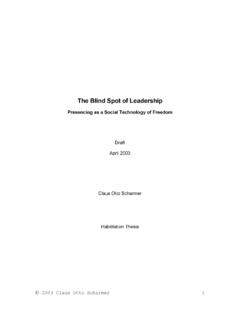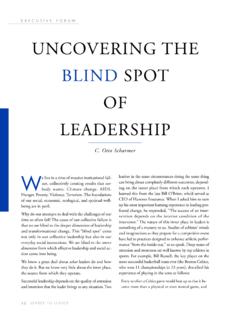Transcription of The Journey to “U” - Otto Scharmer
1 A C h a p t e r 2 The Journey to U Theory U Interview with Brian Arthur at Xerox PARC Francisco Varela on the blind Spot in Cognition Sciences The Inner Territory of leadership Theory U: Beginnings s just discussed, the blind spot concerns the structure and source of our attention. I first began noticing this blind spot in organiza- tions when I spoke with Bill O Brien, the former CEO of Hanover Insurance. He told me that his greatest insight after years of conducting organizational learning projects and facilitating corporate change was that the success of an intervention depends on the interior condition of the inter- vener.
2 That struck a chord! So it s not only what leaders do and how they do it but their interior condition, that is, the inner place from which they oper- ate the source and quality of their attention. So this suggests the same per- son in the same situation doing the same thing can effect a totally different outcome depending on the inner place from where that action is coming. When I realized that, I asked myself: What do we know about that inner place? We know everything about the what and the how, the actions and the processes that leaders and managers use.
3 But what do we know about that T h e o r y 9 inner place? nothing! I wasn t even sure whether there were only one or many of these inner places. Do we have two? Ten? We don t know because it s in our blind spot. yet what I have heard time and time again from pro- found innovators and creative people is that it is exactly that kind of blind spot that matters most. It is that blind spot that sets apart master practition- ers and leaders from average performers. This is why Aristotle over 2,300 years ago made a distinction between normal scientific what knowledge (episteme) and practical and technical how knowledge (phronesis, techne) on the one hand and the inner primary knowing of first principles and sources of awareness (nous) and wisdom (Sophia) on the Shortly after I came to MIT in 1994, I watched a live broadcast on organi- zational learning.
4 In response to a question from the audience, Rick Ross, coauthor of The Fifth Discipline Fieldbook, went to the whiteboard and wrote the following three words: STRUCTURE PROCESS THOUGHT F I g U R E 2 . 1 : L E V E L S O F O R g A n I z A T I O n A L C H A n g E When I saw that simple presentation, I realized that organizational change happens on different layers. In a flash I began mentally seeing these layers. Diagramming them helped, because the changes from structure to process to thoughts present more and more subtle shifts.
5 When I completed the drawing in my mind, I had added two more levels above structure and below thought as well as a horizontal dimension showing change as we move from perceiving something to acting on it. This is how it began to look: I began calling the state at the bottom of the U Presencing. I will talk much more about this in Part III, but for now, we can call it seeing from our deepest source : that is, sensing and operating from one s highest future potential. It is the state each of us can experience when we open not just our T H E J O U R E y T O U RE-ACTING CHALLENGE SOLUTION FOCUSING: RE-STRUCTURING CREATING surfacing new structures current reality and practices BROADENING: RE-DESIGNING CREATING perceiving other new core activities perceptions and processes DEEPENING.
6 RE-FRAMING CREATING dialogue new thinking surfacing deep and principles assumptions RE-GENERATING PURPOSE: Where does our commitment come from? SHARED PERCEPTION: COLLECTIVE ACTION: uncovering common will putting purpose into practice F I g U R E 2 . 2 : F I V E L E V E L S O F C H A n g E minds but our hearts and our wills our impetus to act in order to deal with the new realities emerging all around us.
7 Whenever I used this framework in presentations and in my work with groups, organizations, and communities, I noticed how deeply it resonated with experienced practitioners. As they worked with this U image, people began to understand its two key dimensions. One is the distinction between perception and action that defines the horizontal axis, as we work from deeply connecting and sensing toward enacting and realizing. The vertical axis then shows us the different levels of change from the shallowest response, Re- acting, down through the deepest, Re-generating.
8 Most change and learning methods are based on the Kolb Learning Cycle, which suggests a version of the following sequence: observe, reflect, plan, and act. By grounding the learning process this way, the learning cycles are based T h e o r y on learning from the experiences of the past. The distinction made by Harvard and MIT s Chris Argyris and Don Sch n between single-loop and double-loop learning refers to learning from experiences of the Single-loop learning is reflected in the levels of reacting and restructuring, while reframing is an example of double-loop learning (which includes a reflection of one s deep assumptions and governing variables).
9 However, the deepest level of the U graphic referred to as regenerating goes beyond double-loop learning. It accesses a different stream of time the future that wants to emerge and is what in this book I will refer to as presencing or the U process. The concept of the U, of course, didn t spring from nothing. It emerged from many years of study and work on change in different contexts and move- ments, which are documented in two of my earlier Important sources of my early thinking about social development and change included a global learning Journey whose purpose was to study the dynamics of peace and con- flict (in 1989 1990).
10 It led me to India to study gandhi s approach of nonvio- lent conflict transformation, and to China, Vietnam, and Japan to study Buddhism, Confucianism, and Daoism as different approaches to develop- ment and being. I also had the fortune to work with unique academic teachers, Ekkehard Kappler and Johan galtung, who taught me that critical thinking and science can function as powerful forces for social transformation and change. Other influences on my thinking were the work of the avant-garde artist Joseph Beuys, and the writings of Henry David Thoreau, Martin Buber, Friedrich nietzsche, Edmund Husserl, Martin Heidegger, and J rgen Habermas, as well as some of the old masters like Hegel, Fichte, Aristotle, and Plato.





